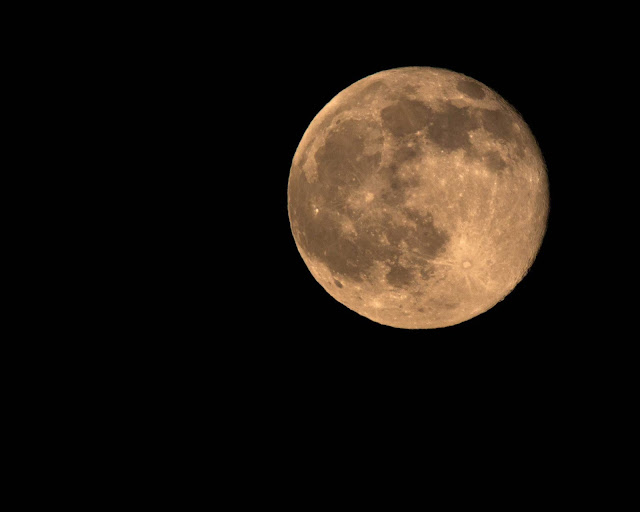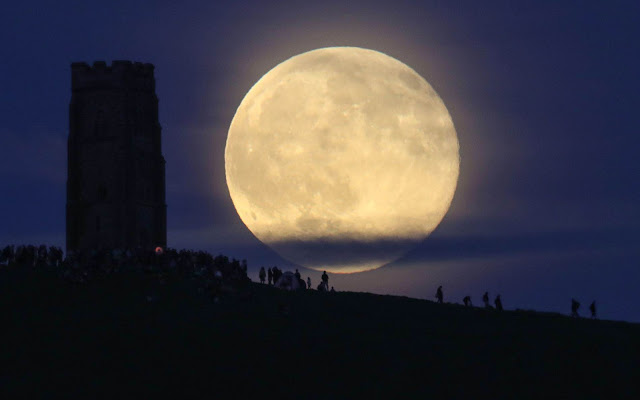This week's report, after last week's digression into astrophysics and astronomy conferences, finally can share some real Astro photos. First up is a photo, taken with just a 600 mm telephoto at Palmia Observatory, shows the "strawberry moon", which just refers to a full moon that
occurs at the same time as the summer solstice. See the attached moon photo, taken about one day after the exact strawberry moon. See attached.
occurs at the same time as the summer solstice. See the attached moon photo, taken about one day after the exact strawberry moon. See attached.
 |
| 600mm DSLR Image taken one day after full strawberry moon (Source: Palmia Observatory) |
The second photo is shared, courtesy of National Geographic, taken in Somerset, England. I like the way the perspective and size of the moon in comparison to the tower is pretty great and hope to capture some images like that too. See attached.
 |
| Moon Image with foreground. Courtesy of National Geographic |
Finally, the OCA Blackstar Canyon party had good warm weather and good turnout. Resident Astronomer Peggy and I set up the big scope and easy chair for binocular viewing. I had two main goals for the evening: (1) Try the auto-aligning camera again and see if I can get better and faster alignments, and (2) Try out the guiding scope, which I bought almost 6 months ago, but hadn't got up the courage to actually try it out. The third attached photo shows the big scope with the guide scope on top of the telescope tube and the auto-alignment camera attached to the bottom of the telescope tube. The Surface Pro controlling the guide scope is on a little table (not shown) below the mount.
 |
| Explore Scientific with attached auto align camera and tracking camera and imaging camera (Source: Palmia Observatory) |
Well, the auto-aligning camera didn't work at all, initially, because the little telephone cable plugs were not completely seated. Ok, ok, yeah I should of checked this out, but you try fiddling around in the dark when things don't work out with your cabling. Anyway, after some fiddling, I figured out what the problem was. Then, even after the camera slewed the scope around and looked at 3 different star fields, it said "Alignment completed". Hooray! But, when I commanded the go to scope,to go to Vega, it was quite disappointing to see that the scope was pointing half dozen degrees off from where it should point. Darn, why is this happening again. I don't know, I couldn't figure it out, so it will just have to wait till next time.
So, I moved on to goal number 2, and tried the guiding camera and guiding software running on the Surface Pro. This experiment seemed to go a little better. The camera showed the visible field on the Surface Pro and I could select the guide star just by clicking on it. The value of this to amateur astronomers is that the tracking of the guide star should compensate for some of the inadequacies inherent in mist low cost amateur telescope mounts, such as slight error in the mounts gearing, etc. This first attempt worked great and I could see that the software kept tracking the star and accounting for Earth rotation. But when I connected the cable from the guide camera to the telescope mount, I got an error message saying the right communication couldn't be maintained. Well, darn, at least part of the experiment was a success and since the night dew was getting quite intense, we decided to pack up and leave before I could find out what was going on.
So, it was sort of successful evening, with a collection, of what all amateurs know, of a few steps forward and a few steps back. At least it was great to see some of the regulars there such as, Amateurs and Radio Hams, Marty and Bonnie, New Amateur with a Celestron, David, and Civil Civil Engineer, Marcello, and a few other amateurs that we're getting great shots, even some views of Mars, which actually seemed to show terrain, or maybe canals, or something. OCA President, Steve, conducted his usual star tour of the night sky. Also, Civil Civil Engineer, Marcello, had just returned from a night at OCA dark sky site in Anza, and shared a great photo of M20, The Trifad. He posted it on the OCA website and it is repeated here. See attached. Thank you Marcello.
 |
| M20, The Trifad, courtesy of OCA Marcello |
Now Resident Peggy and I are in St. Louis (See attached photo from our hotel room) on our way to visit her brother Don in southern Illinois. Don lives in a little town that is also going to be directly in the total eclipse path in August 2017. We considered going there to see the eclipse, but elected, in spite of the mostly free housing there, to see (hopefully) the eclipse in Casper Wyoming. That location has an astronomy conference there before the eclipse, so even if the eclipse gets clouded out, we would enjoy the conference anyway.
If you're interested check out the conference website at: https://astrocon2017.
Until next time,
If you are interested in things astronomical or in astrophysics and cosmology
Check out this blog at www.palmiaobservatory.com

No comments:
Post a Comment